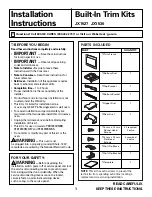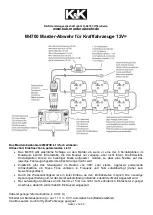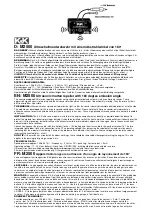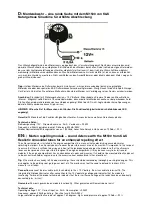
14
Emergency measures
First aid measures:
In case of contact with internal components, corrosive fumes may lead to irritation of
the skin, eyes and mucous membranes. Eczema, skin allergies, lung injuries,
asthma and other respiratory disorders may occur.
•
Contact with skin
: Wash the affected areas of the skin for at least 15 minutes
with plenty of clean, lukewarm water. In case of persisting irritation, injury or
pain, seek medical attention.
•
Contact with eyes
: Rinse for at least 30 minutes with plenty of clean,
lukewarm water without rubbing the eyes. Seek medical attention immediately.
•
Inhalation
: In case of leaking of the battery, contents may lead to irritation of
the airways. Get fresh air immediately. In case of persisting irritation, seek
medical attention.
•
Oral intake:
If swallowed, injuries to tissue in the throat, stomach and
respiratory tract can occur. Seek medical attention immediately.
Medical information:
Dangerous goods include:
Cells containing electrolyte with a corrosive alkali effect
(Lithium salt in organic solvents) with Li, Ni and Co/LiMn oxide cathode; however,
neither Li-metal nor lithium alloys.
Measures in case of accidental release:
On land:
Absorb the electrolyte liquid with sand, place in a suitable container and
notify local fire services / police.
In water:
If possible, remove from the water and notify local fire services / police.
Wear protective clothing:
•
Respiratory mask for organic gases
•
Eye protection
•
Gloves
Hazardous waste must be disposed of at dedicated waste collection points in
compliance with applicable rules and regulations (EWC disposal code: 16 06 05
or 20 01 34).
Measures in case of fire:
In case of fire, until the arrival of the fire department:
If a lithium-ion battery is involved in a fire, flood the area with water. When the
battery is on fire, water may not be sufficient to extinguish it. However, it cools other
batteries nearby and controls the spread of the fire.
CO
2
, dry chemical and foam fire extinguishers are particularly suitable for smaller
fires, but may not be sufficient to extinguish burning lithium-ion batteries. In this
case, the burning battery will burn out.
Virtually all fires involving lithium-ion batteries can be extinguished with water.
However, this should only be done by trained personnel with a sufficiently large
volume of water. When water is used, however, hydrogen can form and lead to an
explosive mixture with air.
LITH-X (graphite powder) or copper powder fire extinguishers, sand, ground
dolomite or sodium carbonate can also be used. These materials are smothering
flames.
When fighting the fire, protective clothing and independent breathing equipment
should be used. Observe the wind direction. Burning lithium-ion batteries can
produce toxic fumes, including hydrogen fluoride, carbon oxides, aluminium, lithium,
copper, and cobalt. Volatile phosphorus pentafluoride can form at temperatures
above 110 °C.
If possible without any risk, remove the batteries from the area of the fire.
After the fire has been successfully controlled, the area must be monitored and
cleaned by trained and properly equipped personnel. Any fire residues must be
properly taken up and disposed of.
After successful extinguishing of fires
After the area to be monitored has been cleared by trained and properly equipped
personnel, the residues must be taken up and disposed of in compliance with
applicable regulations.
Information hotline for lithium-ion batteries
+49 (0) 2261 704-0
Handling and storage
Use and handling of the lithium-ion battery for hand-held garden tools:
In case of normal use and proper disposal, there is no risk of any release of
hazardous substances damaging the environment from the battery.
After use, the battery must be disposed of separately, as it contains hazardous
chemicals, see chapter "Take-back obligations / disposal".
•
The battery may only be charged with chargers recommended by SABO. If
a charger that is only suitable for a specific type of battery is used with other
batteries, there is a risk of fire, explosion and electric shock
•
Only insert the prescribed battery into the garden tool. Using other batteries
can cause injuries or fire.
•
Keep unused batteries away from paper clips, coins, keys, nails, screws or
other small metal objects that could lead to bridging of contacts. A short circuit
between the battery contacts and/or the charging contacts of the charger can
lead to burns or fires.
•
Check the contacts on charger, battery and garden tool for dirt and corrosion.
If necessary, clean professionally.
•
If used incorrectly, liquid may escape from the battery. Avoid direct contact with
the battery. In case of accidental contact, rinse immediately with water. If any
fluids get into your eyes, seek medical attention immediately. Leaking liquids
can cause skin irritation or burns.
•
Do not open the battery. There is a risk of short circuit.
•
Protect the battery from heat, e.g. from direct sunlight, radiators and fires.
There is a risk of explosion.
•
If the battery is damaged and used incorrectly, fumes may escape. Get fresh
air and seek medical attention. Fumes can lead to irritation of the airways.
•
Defective batteries can leak and battery acid can get into contact with
surrounding parts. Check the affected parts. Clean or replace them as
required.
•
The battery should be charged and used in a temperature range between
+7 °C and +40 °C. If the battery is exposed to extreme temperatures, it can
suffer permanent damage.
Intended purpose:
•
The lithium-ion battery is only intended for use with hand-held garden tools and
may not be used for any other purpose.
•
SABO does not accept any liability for damage caused by improper use.
•
Only use original SABO parts. SABO does not accept any liability for damage
caused by use of third-party components or unapproved accessories.
Read all warnings and instructions!
Non-compliance with these safety warnings and instructions may lead to electric
shocks, fires and/or serious injury.
Battery charge for operation:
•
On delivery, the battery is partially charged. Fully charge the battery before first
use. The battery can be recharged at any time. Interruption of the charging
process does not damage the battery.
ATTENTION!
Incorrect handling can lead to explosion or fire! Store batteries away from
children.
Have maintenance and repairs carried out by a SABO representative with
special knowledge on this type of equipment.
Storage:
•
Keep batteries safe. Keep away from children. Short circuits can lead to fires,
explosion and leakage of the battery.
•
The battery must be stored in a cool, dry and well-ventilated space, protected
from moisture, heat sources and open flames. Extreme temperatures can lead
to explosion and leakage of the battery.
•
Storage temperature range: 0 °C to +20 °C
•
Do not store the battery near food and beverages.
•
Maintain sufficient distance between walls and batteries.
•
Batteries are fragile – handle with care, do not throw or drop.
•
If the battery is stored for an extended period, it should be fully charged
approximately every two months.
Содержание SAU22053
Страница 2: ......














































